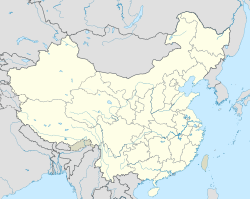Huadu Prison
| Location | No. 2 Hexihu Road, Chini Town, Huadu District, Guangzhou, China |
|---|---|
| Coordinates | 23°22′02″N 113°03′22″E / 23.367178°N 113.056156°E |
| Status | Operational |
| Opened | 1952 |
| Managed by | Guangdong Prison Administrative Bureau |
| Postal code | 510830 |
| Huadu Prison | |||
|---|---|---|---|
| Simplified Chinese | 花都监狱 | ||
| Traditional Chinese | 花都監獄 | ||
| |||
Huadu Prison (Chinese: 花都监狱) has had several different names throughout its history, including Guangzhou No. 1 Reeducation-Through-Labor Facility(Chinese: 广州市第一劳动教养管理所),[1] Chini Town No. 1 Quarry(Chinese: 赤坭镇第一石矿), [2] Chini Quarry(Chinese: 赤坭石矿).[3]
Inmates
[edit]As one of the many Re-education through labor camps established by Mao Zedong, this facility was once used to detain large numbers of former Nationalist soldiers, landlords, sent-down youth, capitalists, critics, and Intellectual outside the Chinese Communist Party. Today, it is still used to imprison political dissidents such as Chen Pokong.
History
[edit]In 2013, Guangzhou No. 1 Re-education-Through-Labor Camp[4] was renamed Guangdong Huadu Prison.[1]
Controversies
[edit]Forced Labor
[edit]Inmates were subjected to intense forced labor, including quarrying stone for more than 14 hours per day and assembling artificial flowers for export to the United States at night. Such as “Silky Touch,” “Lady Bug Collection,” and “Universal Sun Ray”—which were found on products sold in American retail stores including Ben Franklin Stores and WalMart.[5]
An investigation by the Laogai Research Foundation confirmed that products made in Chinese prison camps, including Guangzhou No. 1, had entered the U.S. market, potentially violating U.S. laws prohibiting the importation of goods made with convict or forced labor.[5]
Political Persecution
[edit]The camp is used not merely for criminal rehabilitation but for silencing political dissent.[5]
Human Rights Abuses
[edit]The prison was characterized by widespread physical abuse, including beatings by supervisors and fellow inmates, inadequate medical care, and malnutrition. He described the environment as “hell,” where prisoners are “often beaten until they are bloodstained all over, collapse or lose consciousness.” He reported that even prisoners with serious injuries, including crushed limbs, were forced to work, often leading to permanent disability.[5]
Notable Inmates
[edit]- Chen Pokong(Chinese: 陈破空) - Political commentator.[5]
See also
[edit]References
[edit]- ^ a b 广东省部分劳教场所改为监狱或拘役所 [Some re-education through labor facilities in Guangdong were converted into prisons or detention centers.].
- ^ 广州市第一劳动教养管理所建设工程规划 [Construction Plan for Guangzhou No. 1 Reeducation Through Labor Facility].
- ^ 五十年代赤坭石矿场 [The Chini Stone Quarry in the 1950s].
- ^ "U.S. Customs and Border Protection: Withhold Release Orders (WROs) and Findings related to imports that may involve forced labor".
- ^ a b c d e "Congressional Record: Evidence of slave labor in china".
External links
[edit]- Official website (not secure)


